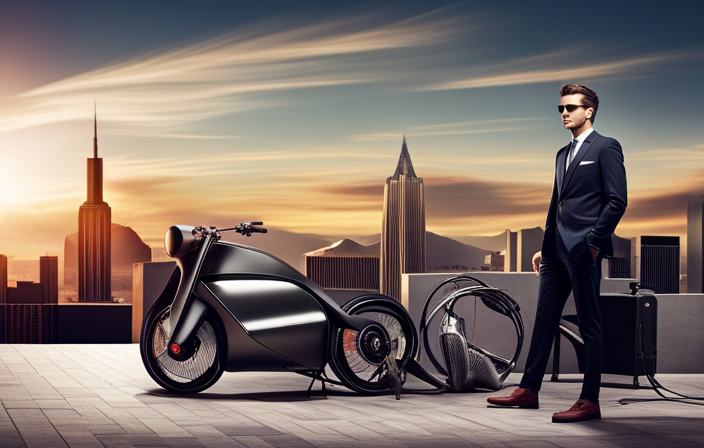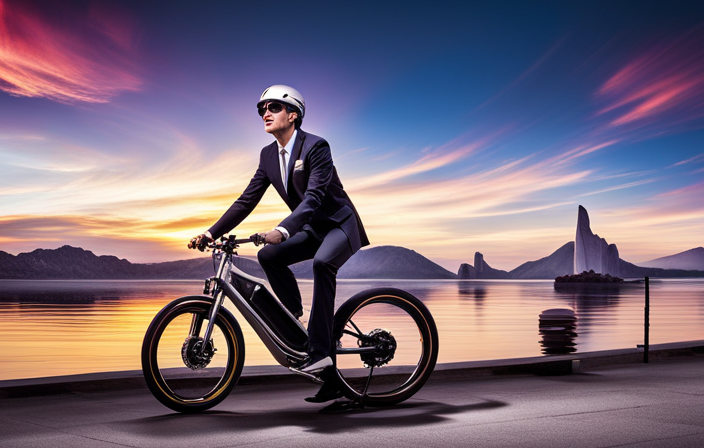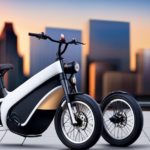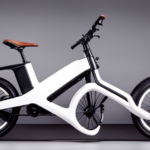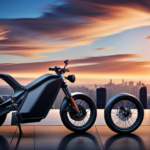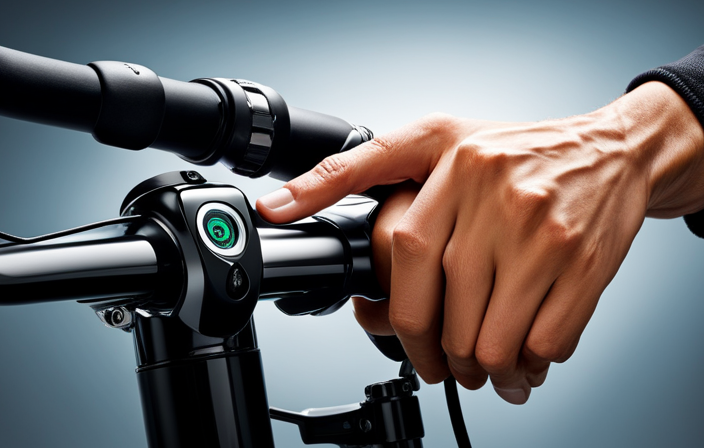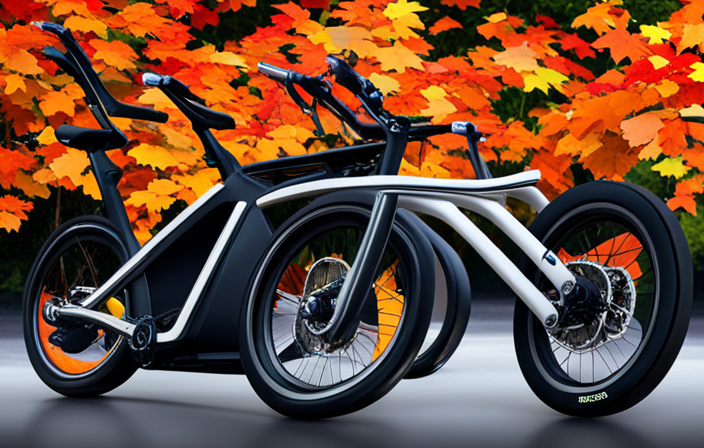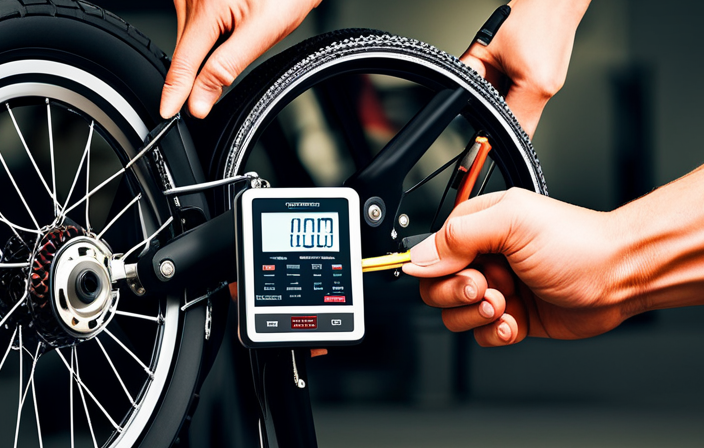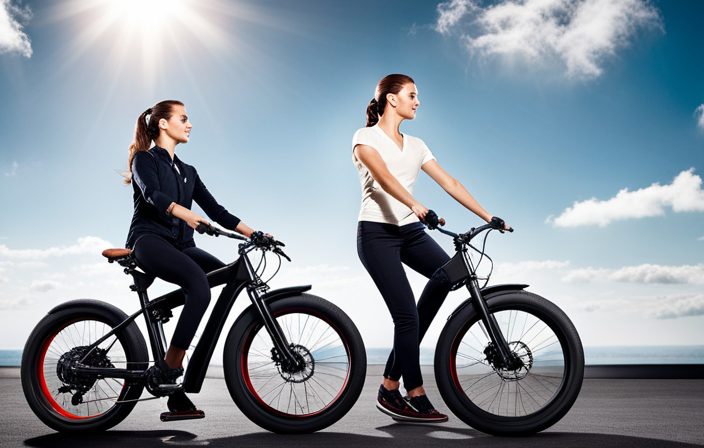Riding an electric bike is akin to sailing on a gentle breeze, smoothly cruising through the streets. However, before you set off on this environmentally friendly journey, it is crucial to take into account the expenses involved.
In this article, I will delve into the various factors that influence the price of electric bikes, from the type and brand to maintenance and repairs.
We’ll also explore the financial benefits and tips for finding the best deals.
So, hop on and let’s uncover the hidden costs of this electrifying mode of transportation.
Key Takeaways
- The cost of an electric bike is influenced by factors such as battery type and capacity, motor power and efficiency, frame material and construction, suspension and braking system, and additional features and accessories.
- Battery type and capacity have a significant impact on the performance and range of an electric bike, with higher capacity and advanced technology resulting in higher cost.
- Maintenance and repair costs should be considered when evaluating the overall cost of owning an electric bike, including battery replacement, motor servicing, and tire and brake maintenance.
- When considering the cost of an electric bike, it is important to also consider the financial benefits and considerations such as financing options, long-term cost analysis, environmental benefits, and tips for finding the best deals.
Types of Electric Bikes
If you’re looking for a fun and eco-friendly way to commute, you’ll love exploring the various types of electric bikes available.
Electric bikes come in different types, each offering unique features and benefits.
One important aspect to consider is the type of motor used in the bike. There are three main types of motors: hub motors, mid-drive motors, and friction drive motors.
Hub motors are popular for their simplicity and affordability, while mid-drive motors provide better balance and power distribution. Friction drive motors, on the other hand, are lightweight and efficient.
Another factor to consider is the battery range options. Electric bikes offer different battery sizes, which determine how far you can ride on a single charge. Higher capacity batteries provide longer ranges, but they also tend to be more expensive.
Now, let’s delve into the factors influencing price.
Factors Influencing Price
When considering the factors that influence the price of an electric bike, it is important to look at several key points.
The battery type and capacity play a significant role in determining the cost, as a higher capacity battery or a more advanced technology will generally result in a higher price.
The motor power and efficiency, frame material and construction, suspension and braking system, as well as additional features and accessories, also contribute to the overall cost of an electric bike.
Battery Type and Capacity
The choice of battery type and capacity significantly impacts the overall cost of an electric bike. The battery is a crucial component that determines the bike’s performance and range. Higher capacity batteries generally offer better performance and longer range, but they also come at a higher cost.
Lithium-ion batteries are the most common type used in electric bikes due to their excellent energy density and long lifespan. These batteries can be charged using different options, such as standard wall outlets or specialized charging stations. However, advanced charging options like fast charging or removable batteries may add to the overall cost.
Considering the battery type and capacity is essential when determining the price of an electric bike.
Moving on to the next section, motor power and efficiency play a vital role in the overall performance of an electric bike.
Motor Power and Efficiency
With a powerful and efficient motor, riders can expect impressive performance from their electric bikes.
When comparing motor power, it’s important to consider both the wattage and the torque. Higher wattage motors generally provide more power, allowing for faster acceleration and better hill climbing capabilities. On the other hand, torque determines the bike’s ability to handle heavy loads and steep inclines.
In terms of efficiency, brushless motors are commonly used in electric bikes. They have low energy consumption and minimal maintenance requirements. These motors use magnets to generate power, resulting in less friction and heat loss compared to brushed motors.
By analyzing motor power and efficiency, riders can choose a bike that fits their specific needs and preferences.
Looking ahead, let’s now shift our focus to the importance of frame material and construction.
Frame Material and Construction
Imagine riding an electric bicycle that is made from lightweight and durable materials, allowing for a smooth and comfortable experience. The frame material and construction of an electric bike play a crucial role in its overall performance and longevity. Here are three key factors to consider:
-
Bike weight: The frame material determines the weight of the electric bike. Opting for lightweight materials like aluminum or carbon fiber can make the bike easier to handle and maneuver, especially on uphill terrains.
-
Durability: Electric bikes with frames made from high-quality materials such as steel or titanium offer exceptional durability. These materials can withstand rough terrains and daily wear and tear, ensuring a longer lifespan for your bike.
-
Lifespan: A well-constructed electric bike frame can significantly impact the lifespan of your bike. By choosing a frame material that is resistant to rust, corrosion, and other weather elements, you can ensure that your electric bike will last for years to come.
Considering these factors, let’s now explore the suspension and braking system of an electric bike.
Suspension and Braking System
Now that we have discussed frame materials and construction, let’s move on to another important aspect of electric bikes: suspension and braking systems.
Electric bike suspension technology has come a long way in recent years, offering riders a smoother and more comfortable ride. Whether it’s front suspension forks or full suspension systems, having a good suspension setup can greatly enhance your riding experience, especially when encountering rough terrain or bumpy roads.
Additionally, a reliable braking system is crucial for the safety of both the rider and those around them. An electric bike’s braking system should be responsive, powerful, and capable of bringing the bike to a quick and controlled stop.
So, when considering the cost of an electric bike, it’s important to factor in the quality of its suspension and braking systems.
Moving forward, let’s delve into the next section about additional features and accessories.
Additional Features and Accessories
To enhance your riding experience, consider adding accessories such as a comfortable saddle, handlebar grips, and a water bottle holder to your electric bike. Electric bike customization allows you to personalize your ride and make it more convenient and enjoyable.
Some top electric bike brands offer a wide range of additional features and accessories to choose from. You can customize your bike with features like fenders to protect you from mud and water splashes, racks to carry your belongings, and lights for better visibility during night rides. These accessories can greatly improve your overall riding experience and make your electric bike more versatile for different purposes.
Moving on to the next section about the price range for electric bikes, it is important to consider these additional features and accessories when determining the cost of an electric bike.
Price Range for Electric Bikes
When it comes to the price range for electric bikes, there are three key categories to consider: entry-level, mid-range, and high-end.
Entry-level electric bikes typically range from $500 to $1,000 and are a great option for those who are new to electric biking.
Mid-range electric bikes fall in the $1,000 to $3,000 range and offer a balance between affordability and quality.
Finally, high-end electric bikes can cost anywhere from $3,000 to $10,000 or more, offering top-of-the-line features and performance.
Entry-Level Electric Bikes
Electric bikes are a fantastic option for those looking for an affordable and eco-friendly mode of transportation. When it comes to entry-level electric bikes, there are a variety of brands to choose from. Some popular electric bike brands in this category include Rad Power Bikes, Swagtron, Ancheer, and ECOTRIC. These bikes typically have a lower price range compared to higher-end models, making them more accessible to a wider range of consumers.
There are several pros and cons to consider when looking at entry-level electric bikes. On the positive side, they are often more affordable, making them a great option for those on a budget. They are also generally lighter and easier to maneuver compared to their higher-end counterparts. However, entry-level electric bikes may have limited range and lower-quality components, which can affect their overall performance and durability.
Now, let’s move on to the next section about mid-range electric bikes.
Mid-Range Electric Bikes
In the realm of mid-range electric bikes, riders can expect a higher level of performance and durability. These bikes are designed for those who want a step up from entry-level models, but are not ready to invest in a high-end option.
Mid-range electric bikes typically come with more advanced features such as larger battery capacities, higher top speeds, and longer range. They also tend to have better components and build quality, ensuring a smoother and more reliable ride.
Some popular mid-range electric bike brands include Rad Power Bikes, Aventon, and Ride1Up. These brands offer a range of models to suit different riding styles and preferences. With their improved specifications and build, mid-range electric bikes provide a great balance between affordability and performance.
Transitioning to high-end electric bikes, riders can expect even more advanced features and top-of-the-line components.
High-End Electric Bikes
With top-of-the-line components and cutting-edge technology, high-end e-bikes offer an unparalleled riding experience. These luxury electric bikes are designed for those who demand the best in terms of performance, comfort, and style. Here are some key features that set high-end e-bikes apart:
-
Powerful Motors: High-end e-bikes are equipped with powerful motors that provide exceptional speed and acceleration.
-
Premium Battery Systems: These bikes come with advanced battery systems that offer longer riding ranges and faster charging times.
-
High-Quality Suspension: To ensure a smooth and comfortable ride, high-end e-bikes feature top-notch suspension systems that absorb shocks and bumps.
-
Premium Design: From sleek frames to premium finishes, luxury electric bikes are designed to turn heads wherever you go.
As we delve into the cost of maintenance and repairs, it’s important to consider the initial investment and ongoing expenses associated with owning a high-end electric bike.
Cost of Maintenance and Repairs
When considering the cost of maintenance and repairs for an electric bike, there are several key points to keep in mind.
Firstly, battery replacement can be a significant expense. Batteries typically have a limited lifespan and can be costly to replace.
Secondly, motor servicing may be necessary over time. This is especially true if the bike is used frequently or for long distances.
Lastly, tire and brake maintenance is essential for safety and longevity. Regular wear and tear can affect the performance of these crucial components.
Overall, it is important to factor in these potential costs when budgeting for the maintenance and repairs of an electric bike.
Battery Replacement
To keep your electric bike running smoothly, you’ll eventually need to replace the battery, which typically costs around $500. The lifespan of an electric bike battery can vary depending on factors such as usage, temperature, and maintenance. On average, a good quality battery can last between 3 to 5 years before it needs to be replaced. When considering the cost of a battery replacement, it is important to compare it with the cost of alternative transportation options. Electric bikes are often more cost-effective than cars or public transportation in the long run. Additionally, investing in a higher quality battery can extend its lifespan and potentially save you money in the long term. Moving forward, let’s explore the next section about motor servicing.
Motor Servicing
Regular motor servicing is essential for maintaining the optimal performance and longevity of your electric bike’s motor. Motor maintenance includes tasks such as cleaning, lubricating, and inspecting the motor components. It is important to regularly check for any signs of wear and tear, such as loose connections or damaged wiring. If any issues are detected, timely motor repair should be carried out to prevent further damage.
Motor servicing not only ensures that your electric bike runs smoothly but also helps in identifying potential problems before they become major issues. By taking care of your motor through regular maintenance and repair, you can extend the lifespan of your electric bike and enjoy a more reliable and efficient ride.
Speaking of maintenance, let’s now move on to tire and brake maintenance, which are equally important for a safe and enjoyable biking experience.
Tire and Brake Maintenance
When it comes to maintaining an electric bike, motor servicing is just one aspect to consider. Now, let’s talk about tire and brake maintenance.
Keeping your tires properly inflated is crucial for optimal performance and safety. Regularly checking the tire pressure and inflating them as needed will ensure a smooth and efficient ride.
Additionally, brake pad replacement is necessary to maintain reliable braking power. Over time, brake pads wear down, reducing their effectiveness. Therefore, it is essential to inspect them regularly and replace them when they become worn or damaged.
To evoke emotion in the audience, here are four key benefits of maintaining your electric bike’s tires and brakes:
- Enhanced safety on the road
- Smoother and more comfortable rides
- Improved handling and maneuverability
- Prolonged lifespan of your electric bike
Now, let’s explore the financial benefits of electric bikes.
Financial Benefits of Electric Bikes
When considering the financial benefits of electric bikes, there are three key points to consider.
First, electric bikes offer savings on fuel and parking expenses, as they can be charged at home and don’t require gasoline.
Second, the reduced maintenance costs of electric bikes compared to traditional bikes can lead to significant savings in the long run.
Lastly, potential tax incentives for purchasing an electric bike can further enhance the financial benefits and make them an attractive option for commuters.
Savings on Fuel and Parking
Imagine the money you could save on fuel and parking with an electric bike – wouldn’t that be incredible? Electric bikes offer significant savings in terms of commuting costs.
First and foremost, you eliminate the need to purchase expensive gasoline or diesel fuel, which can add up over time. Additionally, you can avoid the high costs of parking in congested areas, as electric bikes can be easily parked and locked up almost anywhere.
The savings on fuel and parking expenses alone make electric bikes a cost-effective transportation option. Furthermore, electric bikes require much less maintenance compared to traditional bikes or cars. With fewer moving parts and no need for oil changes or engine tune-ups, the savings on maintenance are substantial.
Transitioning into the next section, these reduced maintenance costs contribute to the overall affordability of electric bikes.
Reduced Maintenance Costs
By opting for an electric bike, you’ll find that the reduced need for regular tune-ups and repairs significantly lowers maintenance expenses. Electric bikes are known for their reliability, requiring minimal maintenance compared to traditional bikes. This not only saves you money but also time and hassle. To illustrate the cost savings, consider the following table:
| Maintenance Tasks | Cost (per year) |
|---|---|
| Tire replacements | $20 |
| Brake adjustments | $30 |
| Chain lubrication | $10 |
| Battery replacements | $0 |
As you can see, the cost of regular maintenance for an electric bike is significantly lower compared to a regular bike. With fewer parts to maintain and replace, you can enjoy a hassle-free riding experience while keeping your expenses in check. Moving forward, let’s explore the potential tax incentives that can further reduce the cost of owning an electric bike.
Potential Tax Incentives
To save even more money, you can take advantage of potential tax incentives when owning an electric bike. These incentives, such as tax credits and government incentives, not only help reduce the initial cost of purchasing an electric bike but also provide ongoing savings.
Here are some potential tax incentives that you may qualify for:
- Federal tax credits: The government offers a federal tax credit of up to a certain amount for the purchase of an electric bike.
- State tax incentives: Some states provide additional tax incentives, such as exemptions from sales tax or income tax deductions.
- Local incentives: Certain cities or municipalities may offer their own incentives, such as rebates or grants.
- Employer benefits: Some employers offer tax-free reimbursements for employees who use electric bikes for commuting.
By taking advantage of these tax incentives, you can significantly reduce the overall cost of owning an electric bike.
Now let’s explore financing options for electric bikes.
Financing Options for Electric Bikes
Electric bikes can be a bit pricey, but there are financing options available for those in need. When considering purchasing an electric bike, it’s important to explore the different financing options that can make it more affordable. Financing an electric bike allows you to spread out the cost over time, making it easier to fit into your budget. There are several benefits to financing an electric bike. First, it allows you to get the bike you want without having to pay the full price upfront. Second, it can help you build credit if you make your payments on time. Lastly, financing options often come with low or even zero-interest rates, saving you money in the long run. Considerations for second-hand electric bikes can include factors such as battery life and overall condition.
Considerations for Second-Hand Electric Bikes
When searching for a pre-owned e-bike, be mindful of factors like battery life and overall condition, as these can greatly impact your riding experience. Evaluating the performance of a second-hand electric bike is crucial to ensure that it meets your needs and expectations. Here are three key considerations when buying a used e-bike:
-
Battery Life: Check the battery’s health and capacity. A worn-out battery may not provide sufficient range, reducing the bike’s usefulness.
-
Overall Condition: Inspect the bike for any signs of wear and tear, such as scratches, rust, or loose parts. A well-maintained bike will likely provide a better riding experience.
-
Benefits of Buying New: While second-hand e-bikes can offer cost savings, buying new allows you to enjoy the latest technology, warranty coverage, and peace of mind knowing that the bike is in pristine condition.
Considering these factors will help you make an informed decision when purchasing a used electric bike. Transitioning to the next section, let’s compare electric bikes with other modes of transportation.
Comparison with Other Modes of Transportation
If you’re looking for a fun and convenient way to get around, comparing e-bikes with other transportation options will give you a clear idea of the benefits they offer.
When it comes to cost comparison, electric bikes are generally more affordable than cars, motorcycles, or public transportation in the long run. The initial cost of an electric bike may seem higher, but when you consider the savings on fuel, insurance, and maintenance, it becomes a cost-effective choice.
Additionally, e-bikes have a lower environmental impact compared to vehicles that run on fossil fuels. They produce zero emissions and contribute to reducing air pollution and greenhouse gas emissions.
Transitioning into the subsequent section about ‘long-term cost analysis’, let’s delve deeper into the financial advantages of owning an electric bike.
Long-Term Cost Analysis
Now, let’s delve into the long-term cost analysis of electric bikes.
When it comes to cost comparison, electric bikes prove to be a more economical mode of transportation. While the initial purchase price may be higher compared to traditional bicycles, the cost of ownership is significantly lower. Electric bikes require minimal maintenance, and the expenses for fuel and parking are virtually nonexistent.
Additionally, compared to cars or motorcycles, electric bikes have lower insurance costs and are not subject to registration fees or vehicle taxes in many places. These factors make electric bikes a cost-effective choice in the long run.
Moving forward, let’s explore the environmental benefits of electric bikes and how they contribute to a sustainable future.
Environmental Benefits of Electric Bikes
Contrary to popular belief, the environmental benefits of utilizing electric bikes are substantial and contribute significantly to a sustainable future. Here are three reasons why electric bikes are environmentally friendly:
-
Reduced Emissions: Electric bikes produce zero tailpipe emissions, helping to improve air quality and reduce greenhouse gas emissions. By choosing an electric bike over a traditional one, you can make a significant positive impact on the environment.
-
Energy Efficiency: Electric bikes are incredibly energy-efficient, requiring only a fraction of the energy consumed by cars or motorcycles. This efficiency translates into lower electricity consumption and a reduced dependence on fossil fuels.
-
Noise Pollution Reduction: Electric bikes operate quietly, minimizing noise pollution in urban areas. This not only improves the overall quality of life for individuals residing in these areas but also benefits wildlife by reducing disturbances.
Considering the financial advantages and positive environmental impact, choosing the right electric bike for your budget is the next logical step.
Choosing the Right Electric Bike for Your Budget
To find an electric bike that fits your budget, you’ll discover a range of options that will make your heart race with excitement. When considering your budget limitations, it’s important to weigh the features and quality of the electric bike against the price. Electric bikes can range in price from a few hundred dollars to several thousand dollars, depending on factors such as brand, battery capacity, motor power, and additional features. Price negotiation is also possible, especially when purchasing from local bike shops or online retailers. Comparing prices and reading customer reviews can help you make an informed decision. In the table below, I’ve listed some popular electric bike models along with their average prices to give you a starting point in your search:
| Electric Bike Model | Average Price |
|---|---|
| Model A | $1,000 |
| Model B | $1,500 |
| Model C | $2,000 |
| Model D | $2,500 |
By understanding the price ranges and considering your budget, you’ll be better equipped to find the best deals on electric bikes that meet your needs and preferences. Transitioning into the next section, let’s explore some tips for finding the best deals on electric bikes.
Tips for Finding the Best Deals
If you’re on a budget but still want to snag a great deal, here are some useful tips for finding the best bargains on your dream electric ride.
First, be sure to do your research and compare prices from different retailers. Look for discounts and promotions, as many stores offer special deals on electric bikes.
Additionally, consider negotiating the price with the seller. Sometimes, they may be willing to lower the price or throw in some extras to make the sale.
Another tip is to check online marketplaces and classified ads for used electric bikes, as they can often be found at lower prices.
Lastly, keep an eye out for seasonal sales or events, as these can be a great opportunity to find discounted electric bikes.
With these tips in mind, you can find the best deals on electric bikes and save some money.
Speaking of saving money, it’s important to consider the additional costs associated with owning an electric bike, which we’ll explore in the next section.
Additional Costs to Consider
When considering the cost of an electric bike, it’s important to factor in additional expenses beyond the bike itself.
Safety gear and accessories are essential for protecting yourself while riding, and these costs can vary depending on your preferences and needs.
Insurance coverage is another consideration, as it can provide financial protection in case of theft or accidents.
Lastly, don’t forget to budget for a bike rack or storage solution to keep your electric bike safe and secure when not in use.
Safety Gear and Accessories
Safety gear and accessories, such as helmets and reflective gear, can significantly increase the overall cost of an electric bike.
Electric bike accessories like baskets, racks, and panniers are popular additions for storage and convenience. These accessories vary in price depending on their quality and brand.
Safety equipment is essential for protecting riders and includes helmets, gloves, knee pads, and reflective gear. These items are crucial for ensuring the rider’s safety, especially during night rides or in areas with heavy traffic.
While the cost of safety gear and accessories can add up, they are necessary investments that can provide peace of mind and enhance the overall riding experience.
Moving on to the next section on insurance coverage, it’s important to consider protection for your electric bike beyond just safety gear.
Insurance Coverage
Insurance coverage provides an added layer of protection and peace of mind for riders looking to safeguard their investment. When considering purchasing an electric bike, it is important to understand the insurance options available. Here are four key points to consider:
-
Coverage options: Insurance policies for electric bikes can vary, so it’s essential to review the coverage options offered by different providers. Look for policies that cover theft, damage, and liability.
-
Cost: The cost of insurance coverage for an electric bike will depend on factors such as the bike’s value, your location, and your riding history. Compare quotes from different insurers to find the most affordable option.
-
Financing options: Some insurance providers offer financing options for their policies. This can be helpful if you prefer to spread out the cost of insurance over monthly payments.
-
Additional benefits: Some insurers may offer additional benefits, such as roadside assistance or coverage for accessories. Consider these extras when choosing an insurance provider.
Considering insurance coverage and financing options are crucial steps in protecting your electric bike investment.
Moving on to the next section, let’s explore bike rack or storage solutions.
Bike Rack or Storage Solutions
Finding the right bike rack or storage solution is like finding a cozy nest for your two-wheeled companion. When it comes to electric bikes, there are various options available to ensure their safety and convenience.
One popular choice is a hitch-mounted bike rack, which securely attaches to the back of your car. These racks come in different sizes and can accommodate multiple bikes, making them ideal for family outings or group rides.
Another option is a wall-mounted bike rack, which saves space by storing your electric bike vertically. Additionally, there are storage solutions specifically designed for electric bikes, such as weatherproof sheds or lockable cabinets. These options provide protection from the elements and theft.
Evaluating the return on investment for these bike rack options and storage solutions is crucial in determining the best choice for your needs.
Evaluating the Return on Investment
When considering the cost of an electric bike, it’s important to weigh the potential return on investment, envisioning the freedom and exhilaration of effortlessly cruising through scenic landscapes.
Evaluating the performance of an electric bike is crucial in comparing the cost benefit. Electric bikes offer a variety of features and capabilities that enhance the overall riding experience. Factors such as battery life, motor power, and overall durability should be considered when evaluating the performance of different models.
Additionally, it is important to compare the cost of an electric bike to alternative modes of transportation, such as owning a car or using public transportation. Electric bikes often prove to be a more cost-effective and eco-friendly option.
In conclusion, evaluating the return on investment of an electric bike involves assessing its performance and comparing its cost benefit to other transportation options.
Conclusion and Final Thoughts
To wrap it all up, remember to take into account the overall benefits and long-term value of your investment in an electric bike. When evaluating the cost of an electric bike, it’s important to consider the financing options available. Many retailers offer flexible payment plans that can help make the purchase more affordable.
Additionally, some cities and organizations provide incentives and subsidies for electric bike purchases, further reducing the cost.
In terms of the environmental impact, electric bikes are a greener alternative to traditional vehicles. They produce zero emissions and contribute to reducing air pollution. By choosing to ride an electric bike instead of driving a car, you’re making a positive contribution to the environment.
In conclusion, while the initial cost of an electric bike may be higher compared to a regular bicycle, the long-term benefits and savings, combined with the positive environmental impact, make it a worthwhile investment. Consider the financing options and environmental benefits when making your decision.
Frequently Asked Questions
Are electric bikes more expensive than regular bikes?
Electric bikes are generally more expensive than regular bikes. When comparing prices, electric bikes tend to have higher upfront costs due to the additional components and technology involved in their design.
What are the financial benefits of owning an electric bike?
Owning an electric bike can bring substantial financial savings and reduce your environmental impact. With lower fuel costs and maintenance expenses, as well as potential tax incentives, it’s a smart investment for your wallet and the planet.
Are there financing options available for purchasing an electric bike?
Yes, there are financing options available for purchasing an electric bike. Many retailers offer electric bike financing with flexible payment options to make it more affordable for customers.
How do electric bikes compare to other modes of transportation in terms of cost?
Commuting on electric bikes is cost-effective. Compared to public transportation, electric bikes offer significant cost savings. They are a cheaper alternative, allowing you to save money on fares and fuel while enjoying a more eco-friendly mode of transportation.
What are the long-term cost benefits of owning an electric bike?
Owning an electric bike offers long-term savings compared to other modes of transportation. The cost comparison shows that with lower maintenance, fuel, and insurance expenses, electric bikes are a cost-effective choice.
Conclusion
After carefully considering all the factors, it is clear that electric bikes are not just a trendy mode of transportation, but a smart investment that will save you money in the long run.
With their affordable price range and low maintenance costs, electric bikes offer unparalleled financial benefits.
Plus, finding the best deals is easier than ever with a little research.
So, don’t miss out on the opportunity to pedal your way to savings and a greener future. Get an electric bike today!
